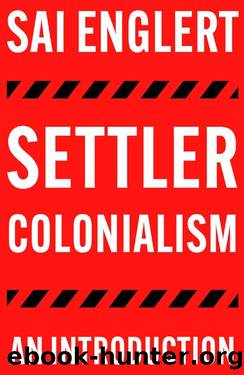Settler Colonialism: An Introduction (FireWorks) by Sai Englert

Author:Sai Englert [Englert, Sai]
Language: eng
Format: epub
Publisher: Pluto Press
Published: 2022-09-19T18:30:00+00:00
INDIGENOUS LAND, ENSLAVED LABOUR
Baconâs Rebellion was ignited in the aftermath of a war waged against the Susquehannock people. Settlers attempted to take over more land for their tobacco plantations and were defeated by the Indigenous nation and their allies. In the aftermath of defeat, both settler landowners and bonded labourers rose up and âtook into their own hands the slaughter of Indigenous farmers with the aim of taking their landâ.52 As Dunbar-Ortiz points out, while the emergence of racism as a tool of social control in the rebellionâs aftermath is important, it should not obscure the fact that it also marked the emergence of an alliance between landowning and poor settlers in the struggle to dispossess Indigenous nations of their land.53
The uprisingâs original goal had been to force the governor of Virginiaâs hand in regards to the speed (rather than the fact) of Indigenous dispossession. However, in doing so, the planters who had stoked the uprising, including Nathaniel Bacon, inadvertently created a space for the expression of the political demands of â both European and African â bonded labourers. The latter, already in arms and in direct confrontation with Governor William Berkeley, demanded tax reform, access to land, and an end to their terms of servitude, radicalising the revolt in the process. Allen notes:
English poet and parliament member Andrew Marvell reported on 14 November 1676 that a ship had recently arrived from Virginia with the news that Bacon had âproclamâd liberty to Servants and Negroâsâ. A letter written from Virginia in October seemed to suggest that a class differentiation had occurred among the rebels: âBaconâs followers having deserted him he had proclaimed liberty to the servants and slaves which chiefly formed his army when he burnt James Town.â54
Although the rebellion survived the death of its eponymous instigator, it was defeated militarily by Berkeleyâs ships in January 1677. Its long-term impact would not be the weakening of settler landownersâ power, but the reverse. Under pressure of continued uprisings (and the threat thereof) by both European and African unfree labourers in the decades that followed the uprising, the settler planters would develop â in Virginia and elsewhere â increasingly rigid laws that racialised Europeans and Africans by making freedom synonymous with Whiteness and servitude with Blackness.
In 1691, the Virginia General Assembly moved beyond allowing owners of African bonded labourers to freely âuse and abuseâ them, when it forbade that they could be set free.55 In 1705, the revised Virginia code limited the levels of violence that could be meted out against âChristian Whiteâ bonded labourers, gave them recourse to the law in cases of excessive abuse, and specified in law the âfreedom duesâ that they were owed at the end of their term.56 At the same time, African bonded-labourersâ livestock was confiscated, while lifetime bonded labourers, increasingly African only, could also not expect freedom dues.57 In 1723, a new Act was passed, with the expressed purpose of âdirecting the trial of Slaves ⦠and for the better government of Negros, Mulattos, and Indians, bond or freeâ.
Download
This site does not store any files on its server. We only index and link to content provided by other sites. Please contact the content providers to delete copyright contents if any and email us, we'll remove relevant links or contents immediately.
The Secret History by Donna Tartt(18947)
The Social Justice Warrior Handbook by Lisa De Pasquale(12166)
Thirteen Reasons Why by Jay Asher(8846)
This Is How You Lose Her by Junot Diaz(6833)
Weapons of Math Destruction by Cathy O'Neil(6215)
Zero to One by Peter Thiel(5732)
Beartown by Fredrik Backman(5679)
The Myth of the Strong Leader by Archie Brown(5457)
The Fire Next Time by James Baldwin(5382)
How Democracies Die by Steven Levitsky & Daniel Ziblatt(5172)
Promise Me, Dad by Joe Biden(5113)
Stone's Rules by Roger Stone(5052)
A Higher Loyalty: Truth, Lies, and Leadership by James Comey(4906)
100 Deadly Skills by Clint Emerson(4880)
Rise and Kill First by Ronen Bergman(4739)
Secrecy World by Jake Bernstein(4700)
The David Icke Guide to the Global Conspiracy (and how to end it) by David Icke(4657)
The Farm by Tom Rob Smith(4465)
The Doomsday Machine by Daniel Ellsberg(4449)
